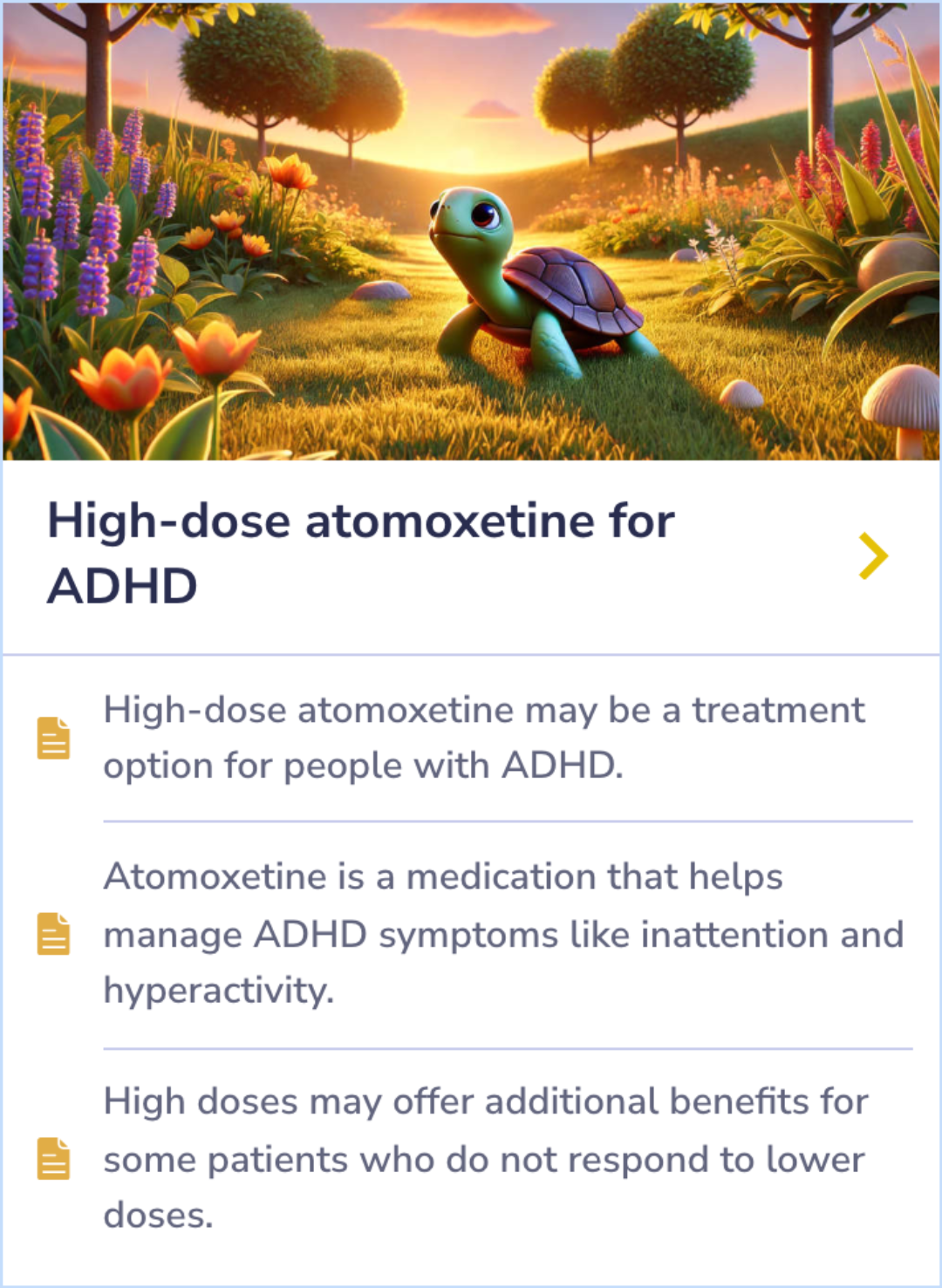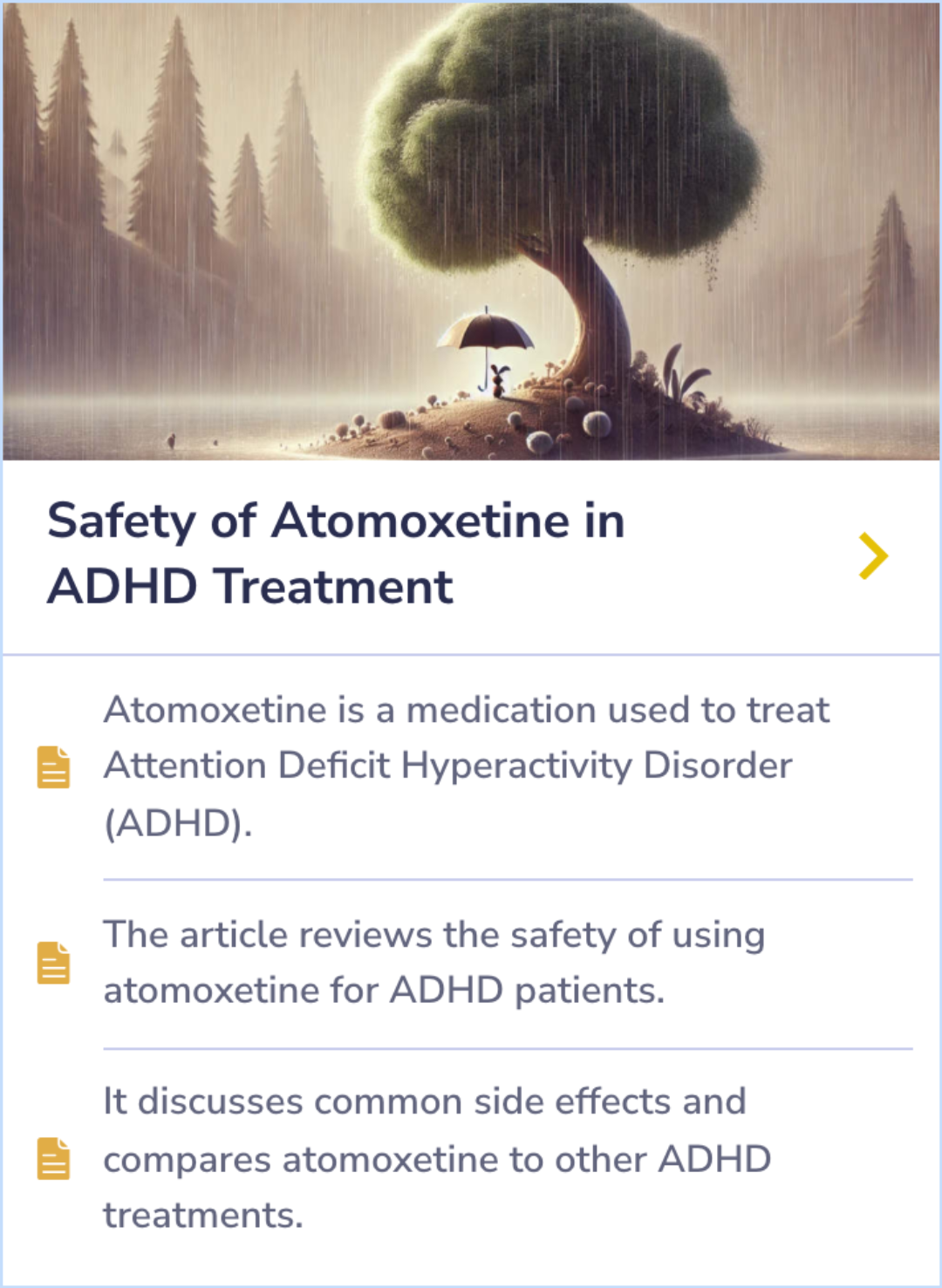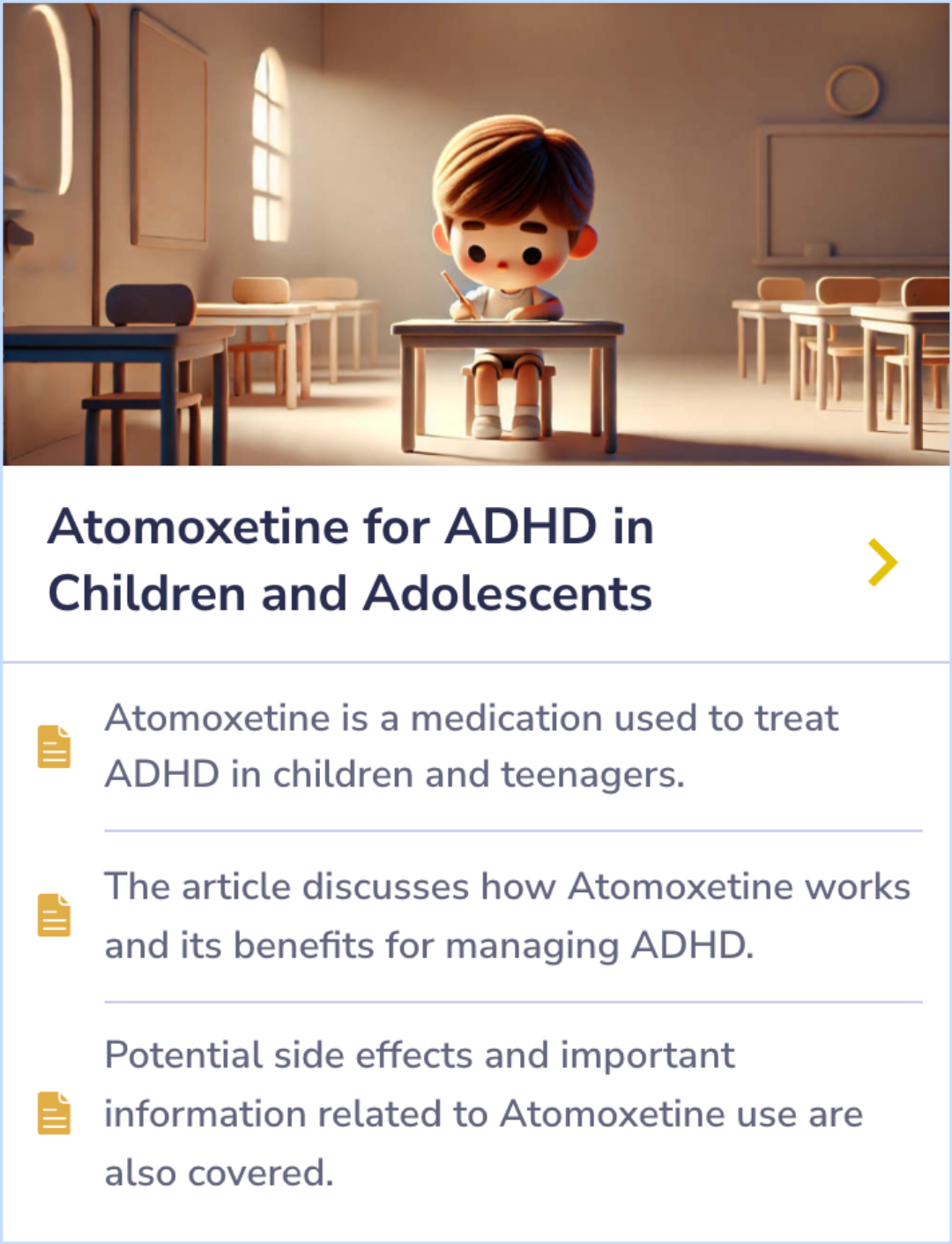Strattera
Studies Summary
🧠
Strattera's Effects on ADHD Symptoms
Strattera (atomoxetine) helps manage ADHD by increasing norepinephrine levels, improving attention, and reducing impulsivity while posing behavioral risks.
👩⚕️
Behavioral Changes in Children and Teens
Children and adolescents on Strattera should be monitored for both positive changes like better focus and negative ones like aggression.
📦
Boxed Warning for Behavioral Risks
Strattera includes a boxed warning due to significant risks of behavioral changes, necessitating vigilant observation particularly in the first weeks.
Highly Cited Studies
Long term Effects of Methylphenidate in Adults
Peer Reviewed Study 1
Strattera’s Impact on Behavior in Children with ODD and ADHD
Peer Reviewed Study 2
Strattera’s impact on ADHD and autism-related behavior
Peer Reviewed Study 3
Strattera and Behavioral Improvement in ADHD
Peer Reviewed Study 4
Behavioral Effects of Strattera in Children and Adolescents
Peer Reviewed Study 5
Behavioral Impact of Strattera in ADHD Treatment
Background: Strattera's Behavioral Impact
Strattera (atomoxetine) is prescribed to help manage ADHD symptoms by increasing norepinephrine levels in the brain. This can improve attention and reduce impulsivity.
However, Strattera has been linked to behavioral changes, particularly in children and adolescents. Positive effects, such as improved focus, and negative effects, including increased aggression or hostility, have been reported.
However, Strattera has been linked to behavioral changes, particularly in children and adolescents. Positive effects, such as improved focus, and negative effects, including increased aggression or hostility, have been reported.
“
Source Quotes:
Atomoxetine is used as part of a total treatment program to increase the ability to pay attention and decrease impulsiveness and hyperactivity in children and adults with ADHD.
Patients beginning treatment for ADHD should be monitored for the appearance or worsening of aggressive behavior or hostility.
Background: Risks of Suicidal Thoughts with Strattera
One of the significant risks associated with Strattera, especially in younger patients, is an increased likelihood of suicidal thoughts or unusual behavioral changes.
These risks are highlighted with a boxed warning, emphasizing the need for careful observation during treatment.
These risks are highlighted with a boxed warning, emphasizing the need for careful observation during treatment.
“
Source Quotes:
Studies have shown that children and teenagers with attention-deficit hyperactivity disorder (ADHD) who take atomoxetine are more likely to think about killing themselves than children and teenagers with ADHD who do not take atomoxetine.
STRATTERA increased the risk of suicidal ideation in short-term studies in children and adolescents with Attention-Deficit/Hyperactivity Disorder (ADHD).
Background: Psychiatric Side Effects of Strattera
Strattera can sometimes lead to psychiatric side effects, including symptoms like hallucinations or delusional thinking.
Although rare, these effects require immediate medical attention and may lead to discontinuation of the medication.
Although rare, these effects require immediate medical attention and may lead to discontinuation of the medication.
“
Source Quotes:
Treatment emergent psychotic or manic symptoms, e.g., hallucinations, delusional thinking, or mania in children and adolescents without a prior history of psychotic illness or mania can be caused by atomoxetine at usual doses.
Monitor for emergence of bipolar disorder/hypomania while the patient is on atomoxetine.
Background: Strattera in ADHD Treatment
Strattera is often used as part of a comprehensive ADHD treatment plan that includes therapy and educational support.
While it is effective in managing symptoms, Strattera does not cure ADHD and must be used consistently as prescribed.
While it is effective in managing symptoms, Strattera does not cure ADHD and must be used consistently as prescribed.
“
Source Quotes:
You should know that atomoxetine should be used as part of a total treatment program for ADHD, which may include counseling and special education.
Atomoxetine is an effective medication for adult ADHD with little to no abuse potential and is not universally classified as a controlled substance.
Peer Reviewed Study
Study: Strattera’s Impact on Behavior in Children with ODD and ADHD
This study explored the effectiveness of Strattera in treating oppositional defiant disorder (ODD) alongside ADHD in children aged 6-12 years. Patients were randomly given either Strattera or a placebo for 8 weeks. The results showed that Strattera was better than placebo in reducing ODD symptoms during weeks 2 and 5, but not by week 8. For ADHD symptoms, Strattera consistently outperformed placebo, showing improvement in overall clinical functioning.
However, while Strattera helped with ADHD, its lasting effect on ODD symptoms was uncertain by the end of the study.
However, while Strattera helped with ADHD, its lasting effect on ODD symptoms was uncertain by the end of the study.
author
Bangs ME, Hazell P, Danckaerts M, Hoare P, Coghill DR, Wehmeier PM, Williams DW, Moore RJ, Levine L; Atomoxetine ADHD/ODD Study Group
journal
Pediatrics
Date Published
2008 Feb
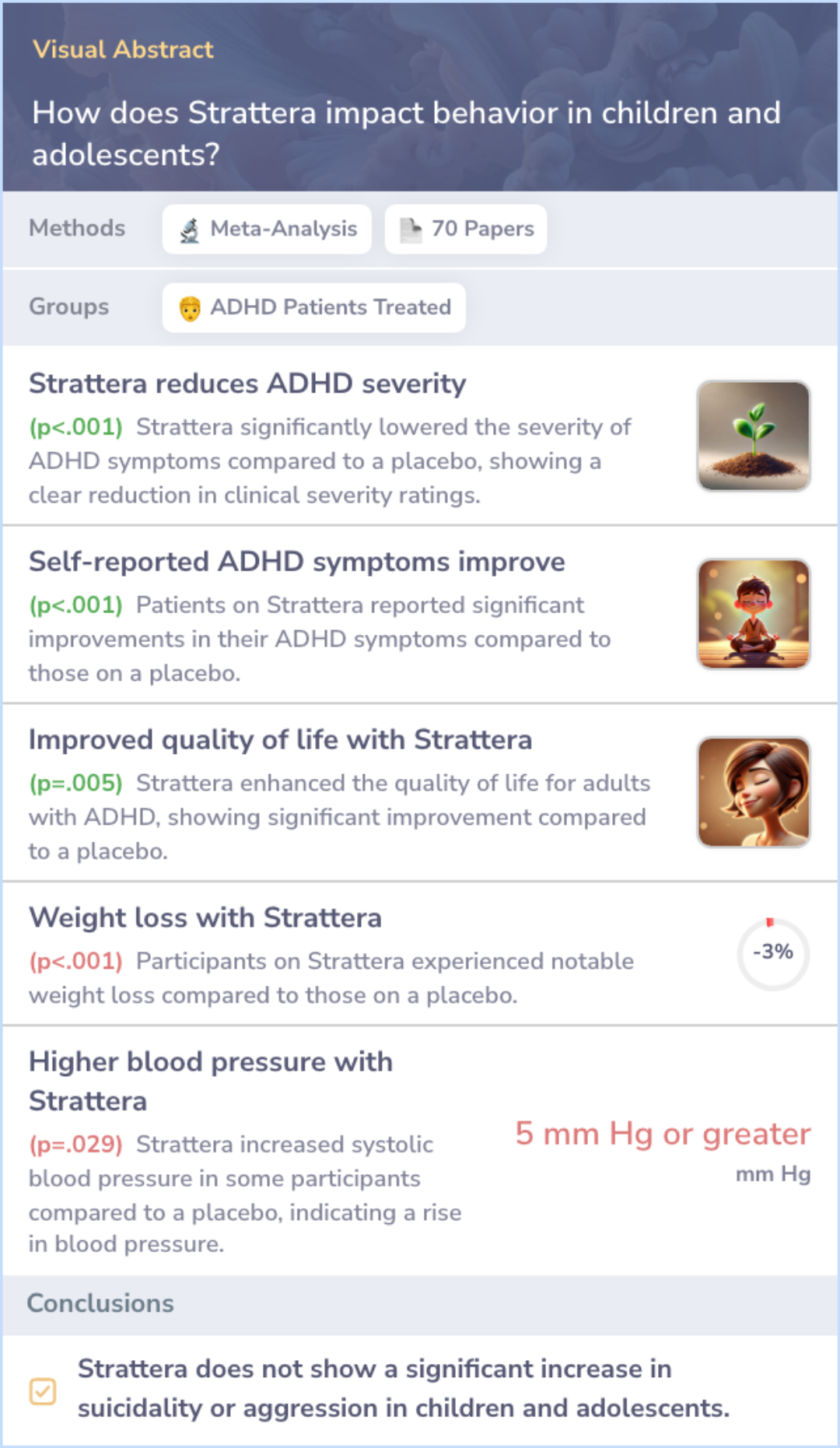
Peer Reviewed Study
Study: Strattera’s impact on ADHD and autism-related behavior
This study examined the effect of Strattera on ADHD symptoms in children with both ADHD and autism. Over 8 weeks, 97 patients received either Strattera or a placebo. Strattera reduced ADHD symptoms more than the placebo, especially in terms of hyperactivity. However, not significantly more patients on Strattera showed marked improvement overall according to the CGI-I scale.
Adverse events were reported in 81.3% of those on Strattera, similar to rates in previous studies. No serious adverse events occurred.
Adverse events were reported in 81.3% of those on Strattera, similar to rates in previous studies. No serious adverse events occurred.
author
Harfterkamp M, van de Loo-Neus G, Minderaa RB, van der Gaag RJ, Escobar R, Schacht A, Pamulapati S, Buitelaar JK, Hoekstra PJ
journal
J Am Acad Child Adolesc Psychiatry
Date Published
2012 Jul

Peer Reviewed Study
Study: Strattera and Behavioral Improvement in ADHD
This study examined the effects of Strattera (atomoxetine) on behavior in adults with ADHD. Participants were given a single dose of Strattera, and their behavior was measured using tasks that assessed response inhibition and working memory. Compared to a placebo, Strattera led to improvements in inhibitory control, as seen by shorter reaction times and fewer errors on attention tasks. These findings indicate that Strattera may help improve certain behaviors linked to ADHD by enhancing brain function.
author
Chamberlain SR, Del Campo N, Dowson J, Müller U, Clark L, Robbins TW, Sahakian BJ
journal
Biol Psychiatry
Date Published
2007-11-01

Peer Reviewed Study
Study: Behavioral Effects of Strattera in Children and Adolescents
This review examined safety data for Strattera (atomoxetine) in treating ADHD, focusing on behavioral concerns like suicidality, aggression, and hostility. A meta-analysis showed no significant link between Strattera and suicidality, while aggression/hostility was slightly more frequent but still not statistically significant. Symptoms like psychosis and mania mainly appeared in those with existing mental health conditions.
The findings suggest that Strattera has a low risk of behavioral side effects in children and adolescents.
The findings suggest that Strattera has a low risk of behavioral side effects in children and adolescents.

Peer Reviewed Study
Study: Behavioral Impact of Strattera in ADHD Treatment
This abstract reviews multiple safety aspects of Strattera (atomoxetine) for children and adolescents with ADHD. It summarizes findings from 70 studies and reports on behavior-related issues, including suicidality and aggression. The data indicate that suicidality is rare with Strattera, and the frequency of aggression is similar to that of placebo-treated patients.
Psychosis and mania were mostly seen in patients with existing bipolar disorder or depression, suggesting these are not common side effects in the general ADHD population.
Psychosis and mania were mostly seen in patients with existing bipolar disorder or depression, suggesting these are not common side effects in the general ADHD population.
author
Reed VA, Buitelaar JK, Anand E, Day KA, Treuer T, Upadhyaya HP, Coghill DR, Kryzhanovskaya LA, Savill NC
journal
CNS Drugs
Date Published
2016 Jul

Key Takeaways
Conclusions
Strattera, known generically as atomoxetine, is utilized to manage ADHD symptoms by enhancing norepinephrine levels in the brain, which can bolster attention and lessen impulsivity. However, it carries the potential for significant behavioral changes, including positive effects like improved focus and adverse effects such as increased aggression or hostility.
Studies have highlighted severe risks, including suicidal thoughts and psychotic symptoms, necessitating vigilant monitoring, particularly in children and adolescents. Strattera is most effective as part of a comprehensive treatment plan that involves behavioral therapy and educational support, requiring consistent use and careful supervision to mitigate potential risks and maximize positive outcomes.
Studies have highlighted severe risks, including suicidal thoughts and psychotic symptoms, necessitating vigilant monitoring, particularly in children and adolescents. Strattera is most effective as part of a comprehensive treatment plan that involves behavioral therapy and educational support, requiring consistent use and careful supervision to mitigate potential risks and maximize positive outcomes.
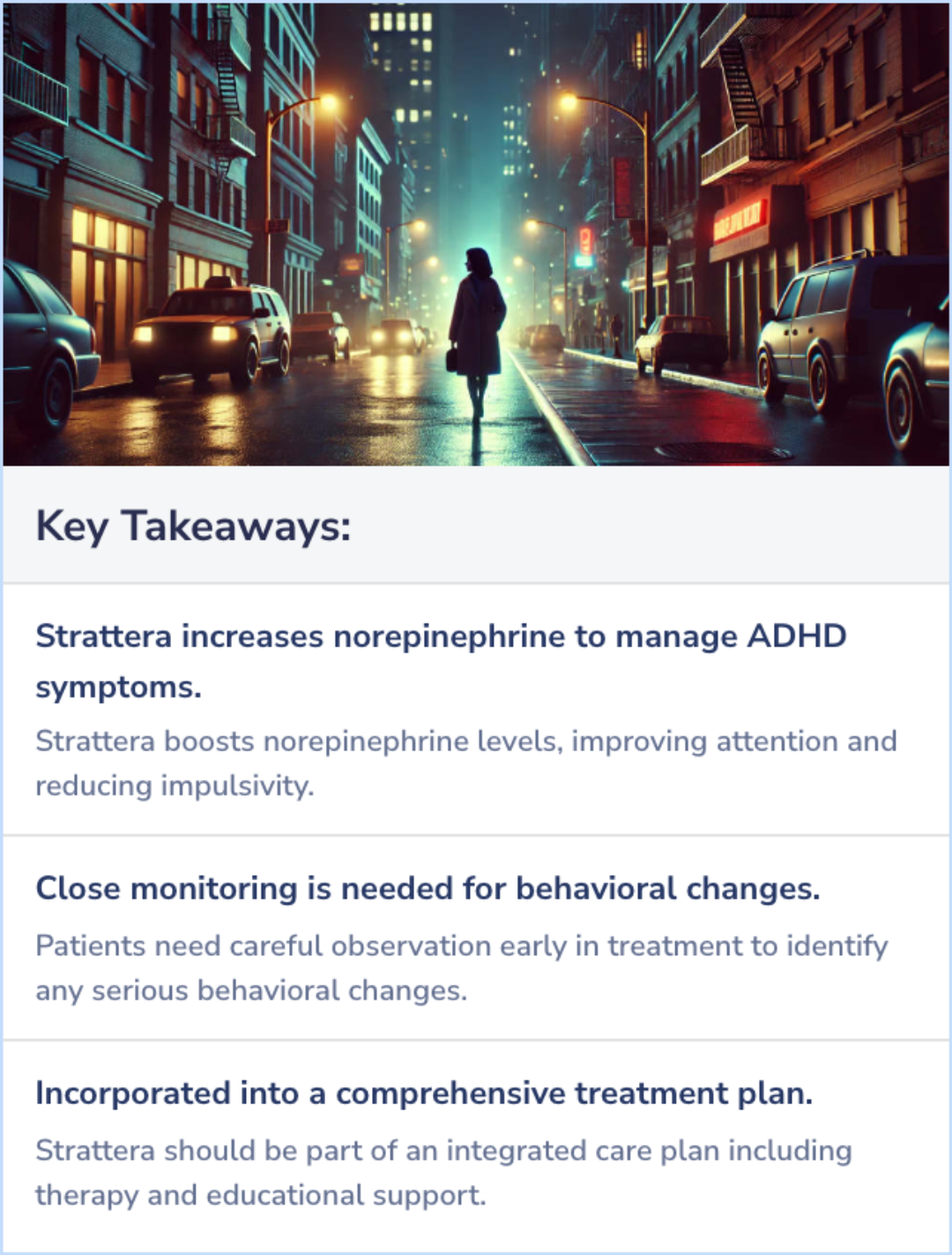
Evidence Summary
High-Dose Atomoxetine: A Potential ADHD Treatment Option
High doses of atomoxetine may offer additional benefits for patients with ADHD who do not respond to standard doses. This treatment option focuses on managing symptoms like inattention and hyperactivity, especially in individuals unresponsive to typical dosages. The content highlights the potential advantages of adjusting atomoxetine levels to improve symptom management in these cases.
Adjusting atomoxetine dosages could be crucial for enhancing outcomes in those who need more than the standard dose.
Adjusting atomoxetine dosages could be crucial for enhancing outcomes in those who need more than the standard dose.
Evidence Summary
Comparing Atomoxetine's Safety with Other ADHD Treatments
Atomoxetine, commonly prescribed for ADHD, has a distinct safety profile. The discussion centers on typical side effects and how these compare with other treatment options available for ADHD.
For those considering treatment, this exploration offers a clear picture of what to expect in terms of safety, allowing for more informed decision-making regarding the use of atomoxetine.
For those considering treatment, this exploration offers a clear picture of what to expect in terms of safety, allowing for more informed decision-making regarding the use of atomoxetine.
Evidence Summary
How Atomoxetine Manages ADHD in Children and Teenagers
Atomoxetine, commonly used to treat ADHD in children and teenagers, works by managing symptoms such as inattention and hyperactivity. The article highlights how this medication can help in controlling ADHD behaviors, while also noting the potential side effects that may arise.
It emphasizes the importance of being aware of these side effects and taking necessary precautions when using Atomoxetine for ADHD treatment in young patients.
It emphasizes the importance of being aware of these side effects and taking necessary precautions when using Atomoxetine for ADHD treatment in young patients.
